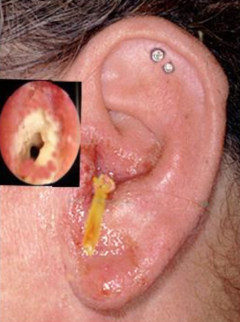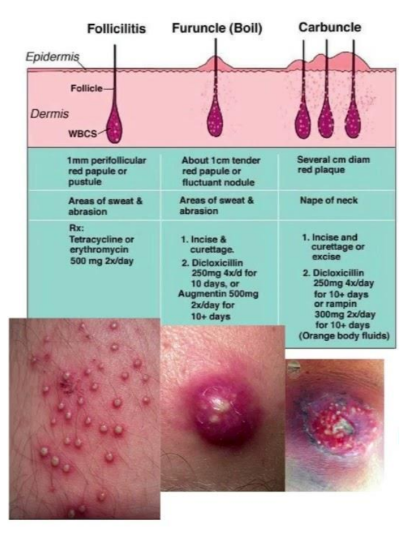Skin and Ocular Infectious Diseases
1/15
There's no tags or description
Looks like no tags are added yet.
Name | Mastery | Learn | Test | Matching | Spaced |
|---|
No study sessions yet.
16 Terms
epidermis
outer layer of the skin (keratinized)
dermis
middle layer of skin (connective tissue, glands, follicles)
subcutaneous tissue
deepest layer of skin (fat, vessels, nerves)
Exogenous
*route of infection
from outside (cuts, trauma, bites)
endogenous
*route of infection
from normal microbiota
staphylococcus aureus
Gram-positive cocci
catalase+, coaglualse +
diseases: folliculitis, impetigo, abscesses
staphylococcus epidermis
gram-positive cocci
catalase +, coagulase -
forms biofilms
causes chronic device-associated infections
streptococcus pyogenes
gram positive cocci in chains
catalase -, β-hemolytic
Diseases: impetigo, erysipelas, cellulitis, “flesh eating disease”
pseudomonas aeruginosa
gram-negative rod
oxidase +
found in water, soil, moist environments
typical infections: folliculitis, “simmers ear”, burn wounds
otitis externa “swimmers ear”
Anatomy: skin-lined canal → similar to other skin infections
Main pathogens:
• Pseudomonas aeruginosa (most common)
• Staphylococcus aureus
• Candida spp., Aspergillus spp. (fungal otitis)
Clinical: pain, itching, redness, swelling, discharge
Treatment: cleaning + topical antibiotics (ciprofloxacin) ± antifungals

folliculitis
Inflammation/infection of the
hair follicle.
Main pathogen:
Staphylococcus aureus
Common sites: beard, scalp, chest,
thighs
Predisposing factors: shaving, friction,
occlusion, sweat
Treatment: hygiene + topical antibiotics
(mupirocin, clindamycin)

furuncle and carbuncle
Furuncle (boil): deep infection of hair follicle →
abscess
Carbuncle: cluster of interconnected furuncles
Main pathogen:
Staphylococcus aureus
Clinical: painful, red, fluctuant nodules with pus
Treatment: incision & drainage ± antibiotics (MRSA
coverage if needed)

Impetigo
Etiology:
Staphylococcus areas (most common)
streptococcus pyogenes
Clinical features:
honey-colored crust around the nose and mouth
blisters
Diagnosis:
swab from active lesion
treatment:
topical mupirocin
oral cephalexin, dicloxacillin, clindamycin
*common in children, spreads by contact/ scratching, and is very contagious
erysipelas
Infection of the dermic and lymphatic blood vessels
Etiology:
streptococcus pyogenes
Clinical features:
bright red, swollen, hot skin with raised borders
Diagnosis
swab from legion edge if open
cellulitis
Etiology:
Staphylococcus areas
streptococcus pyogenes
sometimes both
entry via. skin trauma, ulcers, surgical wounds
clinical features
redness, swelling, pain, heat, tenderness
poorly defined borders
diagnosis:
clinical evaluation
treatments
antibiotics
necrotizing fasciitis
infection of the fascia and deep subcutaneous tissue, often producing gas and necrosis
Pathogens:
streptococcus pyogenes
clostridium perfringens
clinical features:
severe pain
rapid swelling and skin discoloration (purple)
necrosis, blisters and crepitus (gas under skin)
diagnosis:
clinical suspicion with CT scan and tissue culture
treatment:
emergency surgery
IV broad-spectrum antibiotics